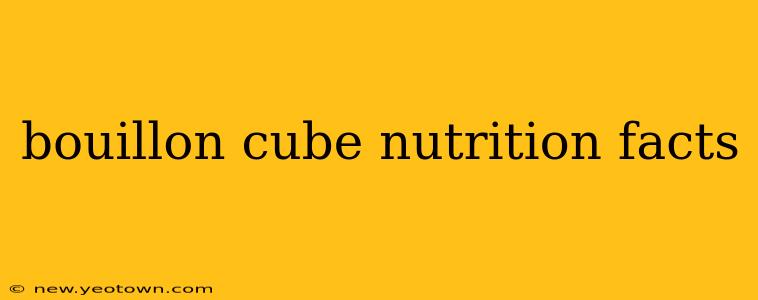The humble bouillon cube. A tiny powerhouse of flavor, it transforms a simple pot of water into a savory broth, the base for countless soups, sauces, and stews. But have you ever stopped to consider the nutritional content hidden within that tiny, concentrated cube? Let's embark on a journey to uncover the surprising nutritional facts and address some frequently asked questions about bouillon cubes.
What are the main ingredients in bouillon cubes?
Bouillon cubes typically consist of salt, flavor enhancers (like yeast extract and monosodium glutamate – MSG), dehydrated vegetables, meat extracts (if it's beef, chicken, or vegetable bouillon), and various spices. The exact composition varies significantly depending on the brand and type (beef, chicken, vegetable, etc.). Some brands might prioritize natural ingredients and minimal additives, while others lean toward cost-effectiveness, leading to a higher proportion of salt and flavor enhancers. Reading the ingredient list carefully is crucial to understanding what you're consuming. The story of bouillon cubes is, in fact, a story of innovation in food preservation and flavor enhancement. Early versions were far less refined, but over time, manufacturers perfected the process, resulting in the convenient and flavorful cubes we know today.
How many calories are in a bouillon cube?
The caloric content of a single bouillon cube is generally low, typically ranging from 5 to 15 calories. This low calorie count is largely due to the dehydrated nature of the ingredients. The majority of the calories come from carbohydrates and a small amount from protein. However, it's important to remember that this is just the cube itself. Once you dissolve it in water, you're essentially adding a negligible amount of calories to your broth, soup, or sauce.
Are bouillon cubes healthy?
Whether bouillon cubes are "healthy" is a complex question with no simple yes or no answer. They can be part of a balanced diet, but moderation is key. The high sodium content is a significant concern. Excessive sodium intake is linked to high blood pressure and other health problems. Additionally, some brands utilize artificial colors, flavors, and preservatives, which some people choose to avoid. However, many brands are now offering lower-sodium and organic options that prioritize natural ingredients. Ultimately, the healthfulness of a bouillon cube depends largely on the brand, its ingredient list, and your overall dietary habits.
What are the nutritional benefits of bouillon cubes?
While not a significant source of essential nutrients, bouillon cubes can contribute some vitamins and minerals, particularly if they are made with vegetable extracts and fortified. They can provide small amounts of potassium, iron, and certain B vitamins. The nutritional value, however, pales in comparison to whole foods like fresh vegetables or meat, so it’s important to not rely on bouillon cubes as your primary source of these nutrients.
Are there low-sodium bouillon cubes available?
Yes, many brands now offer low-sodium or reduced-sodium bouillon cubes. Checking the nutrition label to compare sodium content between different brands is essential for making informed choices. Lower-sodium options help reduce the sodium intake associated with regular bouillon cubes, making them a more suitable option for individuals watching their sodium consumption.
How much sodium is in a bouillon cube?
The sodium content varies drastically across brands and types. It's not uncommon to find anywhere from 700mg to over 1000mg of sodium in a single cube. That’s a significant portion of the recommended daily sodium intake (generally around 2300mg or less), highlighting the importance of choosing low-sodium options and using them sparingly.
In conclusion, bouillon cubes offer a convenient and flavorful way to enhance your cooking, but mindful consumption is essential. By understanding the nutritional content and choosing carefully, you can enjoy the benefits of this versatile ingredient without compromising your health. Always check the nutrition label and ingredient list before purchasing to make informed choices that align with your dietary goals.

